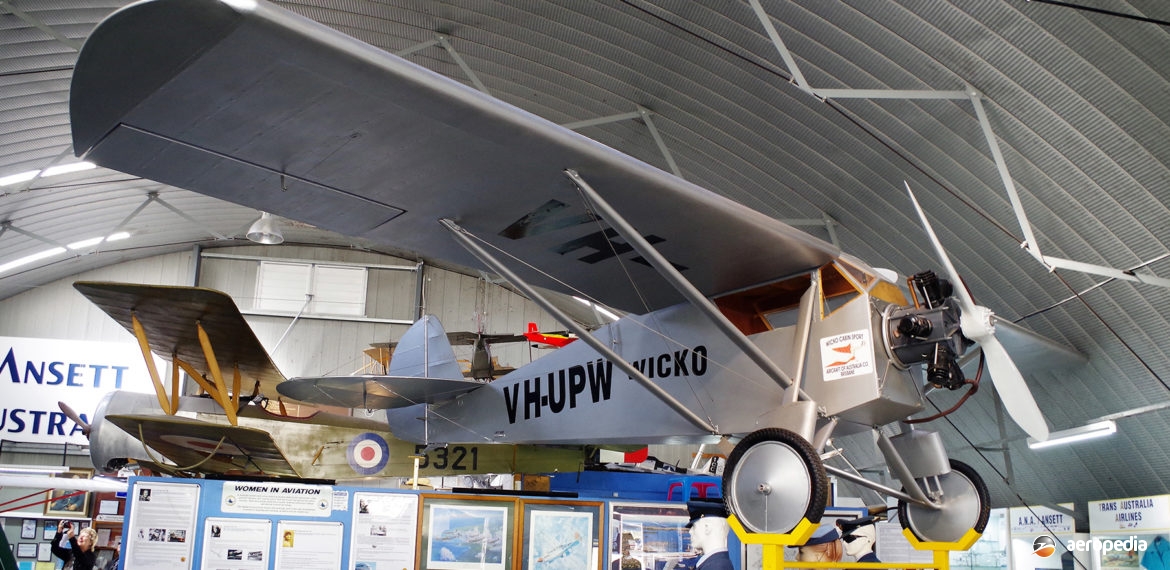Photograph:
Cabin Sports replica VH-UPW at the Queensland Air Museum at Caloundra, QLD (N Sayer via Ron Cuskelly)
Country of origin:
Australia
Description:
Light touring biplane
Power Plant:
One 45 kw (60 hp) Anzani six-cylinder radial air-cooled engine
Specifications:
- Wingspan: 8.53 m (28 ft)
- Length: 5.48 m (18 ft)
- Wing area: 11.33 m² (122 sq ft)
- Max speed: 129 km/h (80 mph)
- strong>Cruising speed: 97 km/h (60 mph)
- Stalling speed: 64 km/h (40 mph)
- Time to climb to 1,524 m (5,000 ft): 11 mins 28 seconds
- Empty weight: 245 kg (540 lb)
- Loaded: 408 kg (900 lb)
History:
In 1929 Geoffrey Neville Wikner (1904 – 1990) purchased a second-hand but badly damaged Farman Sport biplane and rebuilt it, at that time registering a company as the Aircraft of Australia Aviation Co, and set about barnstorming in Queensland. This aircraft crashed and was wrecked. He moved on and built a glider from the wreck, but this was also wrecked in an accident. It is said the flights with the glider (known as the Golden Sparrow) were the first controlled glider flights made in Queensland.
With others Wickner set up a business, Associated Gliding Clubs of Queensland, and obtained the design rights to the German Zoegling glider. He manufactured and supplied pre-fabricated glider kits and drawings to clubs which he established to enable them to build their own gliders, he himself usually being the test pilot of those completed. At about this time he also built a light aircraft known as the Wicko Cabin Sports, also known as the Wicko Sports and Wikner Wicko, this aircraft making its first flight on 25 January 1931 at Archerfield, QLD in the hands of a pilot named Foxcroft-Jones.
On 6 February 1931 the aircraft was registered to G N Wikner, trading as Aircraft of Australia, Brisbane, QLD as VH-UPW (c/n 1) and Certificate of Registration No 421 was issued. This machine was powered by a 45 kw (60 hp) six-cylinder Anzani radial engine which had previously been installed in his Farman Sport. Newspaper reports at the time said, “This interesting plane, the first product of Aircraft of Australia Co, was entirely designed and constructed by Mr Geoff Wikner…This first flight of a truly Queensland aeroplane on Sunday last was followed with interest by a large gathering of flying enthusiasts at Brisbane’s new aerodrome. With pilot Foxcroft-Jones at the controls, the little monoplane ‘unstuck’ after a remarkably short run of 80 yards (73 meters)…But once in the air with the Wicko climbing merrily, he decided to extend the flight and in a remarkably short space of time the altimeter of the Wicko was registering 3000 ft (914 metres).” Wikner himself, after 1 hr 40 mins dual instruction on a de Havilland Moth, went solo on the Wicko on Anzac Day 1931 and, after 4 hours solo on it, established a light aircraft altitude record.
At a later stage the Wicko was flown by Sir Charles Kingsford Smith, he describing it as “an amazing little machine, with absolutely no vices”. One of his flights was described: “Taking off toward and only 150 yards (137 metres) from the hangar it appeared at first glance the machine must strike the building. Within twenty yards (18 metres) the Wicko was clear of the ground and to the amazement of the onlookers it cleared the flagpole on the roof of the hangar by at least 100 feet (30 metres) climbing to 1,000 feet (305 metres) in the remarkable time of 48 seconds. Kingsford Smith attempted to stall the Wicko; the Wicko refused to stall. At the top of a steep climb with air speed below 40 miles an hour (64 km/h) the machine veritably floated for quite an appreciable time and then lowered its nose into a gentle glide.” On 24 February 1931 the Queensland Governor, Sir John Goodwin, performed a christening ceremony for the aircraft.
On 17 May 1931 Wikner flew the Wicko to what was described as an Australian altitude record for light planes of 5,181 m (17,000 ft), the record being established without oxygen. However, funds for the development of the aircraft were lost by a business partner and the aircraft was sold by creditors to a Mr Fordham. At this stage news was received from the Department of Civil Aviation that the structural strength of the aircraft did not meet requirements and the aircraft was grounded. Wikner then set about designing and building the Lion, to which he fitted the Anzani engine. This aircraft and the Wizard are dealt with elsewhere.
A replica of the Wicko has been constructed for the Queensland Air Museum by Edward Foster and, painted as VH-UPW, it was unveiled at the museum at Caloundra on 1 July 2007.

